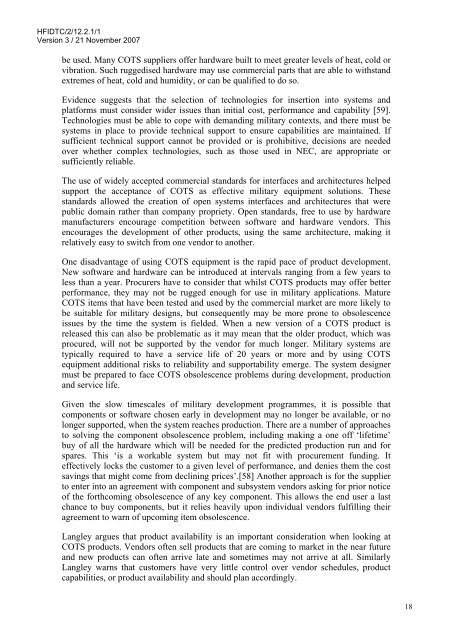The Impact of Technology Insertion on Organisations
The Impact of Technology Insertion on Organisations
The Impact of Technology Insertion on Organisations
Create successful ePaper yourself
Turn your PDF publications into a flip-book with our unique Google optimized e-Paper software.
HFIDTC/2/12.2.1/1<br />
Versi<strong>on</strong> 3 / 21 November 2007<br />
be used. Many COTS suppliers <str<strong>on</strong>g>of</str<strong>on</strong>g>fer hardware built to meet greater levels <str<strong>on</strong>g>of</str<strong>on</strong>g> heat, cold or<br />
vibrati<strong>on</strong>. Such ruggedised hardware may use commercial parts that are able to withstand<br />
extremes <str<strong>on</strong>g>of</str<strong>on</strong>g> heat, cold and humidity, or can be qualified to do so.<br />
Evidence suggests that the selecti<strong>on</strong> <str<strong>on</strong>g>of</str<strong>on</strong>g> technologies for inserti<strong>on</strong> into systems and<br />
platforms must c<strong>on</strong>sider wider issues than initial cost, performance and capability [59].<br />
Technologies must be able to cope with demanding military c<strong>on</strong>texts, and there must be<br />
systems in place to provide technical support to ensure capabilities are maintained. If<br />
sufficient technical support cannot be provided or is prohibitive, decisi<strong>on</strong>s are needed<br />
over whether complex technologies, such as those used in NEC, are appropriate or<br />
sufficiently reliable.<br />
<str<strong>on</strong>g>The</str<strong>on</strong>g> use <str<strong>on</strong>g>of</str<strong>on</strong>g> widely accepted commercial standards for interfaces and architectures helped<br />
support the acceptance <str<strong>on</strong>g>of</str<strong>on</strong>g> COTS as effective military equipment soluti<strong>on</strong>s. <str<strong>on</strong>g>The</str<strong>on</strong>g>se<br />
standards allowed the creati<strong>on</strong> <str<strong>on</strong>g>of</str<strong>on</strong>g> open systems interfaces and architectures that were<br />
public domain rather than company propriety. Open standards, free to use by hardware<br />
manufacturers encourage competiti<strong>on</strong> between s<str<strong>on</strong>g>of</str<strong>on</strong>g>tware and hardware vendors. This<br />
encourages the development <str<strong>on</strong>g>of</str<strong>on</strong>g> other products, using the same architecture, making it<br />
relatively easy to switch from <strong>on</strong>e vendor to another.<br />
One disadvantage <str<strong>on</strong>g>of</str<strong>on</strong>g> using COTS equipment is the rapid pace <str<strong>on</strong>g>of</str<strong>on</strong>g> product development.<br />
New s<str<strong>on</strong>g>of</str<strong>on</strong>g>tware and hardware can be introduced at intervals ranging from a few years to<br />
less than a year. Procurers have to c<strong>on</strong>sider that whilst COTS products may <str<strong>on</strong>g>of</str<strong>on</strong>g>fer better<br />
performance, they may not be rugged enough for use in military applicati<strong>on</strong>s. Mature<br />
COTS items that have been tested and used by the commercial market are more likely to<br />
be suitable for military designs, but c<strong>on</strong>sequently may be more pr<strong>on</strong>e to obsolescence<br />
issues by the time the system is fielded. When a new versi<strong>on</strong> <str<strong>on</strong>g>of</str<strong>on</strong>g> a COTS product is<br />
released this can also be problematic as it may mean that the older product, which was<br />
procured, will not be supported by the vendor for much l<strong>on</strong>ger. Military systems are<br />
typically required to have a service life <str<strong>on</strong>g>of</str<strong>on</strong>g> 20 years or more and by using COTS<br />
equipment additi<strong>on</strong>al risks to reliability and supportability emerge. <str<strong>on</strong>g>The</str<strong>on</strong>g> system designer<br />
must be prepared to face COTS obsolescence problems during development, producti<strong>on</strong><br />
and service life.<br />
Given the slow timescales <str<strong>on</strong>g>of</str<strong>on</strong>g> military development programmes, it is possible that<br />
comp<strong>on</strong>ents or s<str<strong>on</strong>g>of</str<strong>on</strong>g>tware chosen early in development may no l<strong>on</strong>ger be available, or no<br />
l<strong>on</strong>ger supported, when the system reaches producti<strong>on</strong>. <str<strong>on</strong>g>The</str<strong>on</strong>g>re are a number <str<strong>on</strong>g>of</str<strong>on</strong>g> approaches<br />
to solving the comp<strong>on</strong>ent obsolescence problem, including making a <strong>on</strong>e <str<strong>on</strong>g>of</str<strong>on</strong>g>f ‘lifetime’<br />
buy <str<strong>on</strong>g>of</str<strong>on</strong>g> all the hardware which will be needed for the predicted producti<strong>on</strong> run and for<br />
spares. This ‘is a workable system but may not fit with procurement funding. It<br />
effectively locks the customer to a given level <str<strong>on</strong>g>of</str<strong>on</strong>g> performance, and denies them the cost<br />
savings that might come from declining prices’. [58] Another approach is for the supplier<br />
to enter into an agreement with comp<strong>on</strong>ent and subsystem vendors asking for prior notice<br />
<str<strong>on</strong>g>of</str<strong>on</strong>g> the forthcoming obsolescence <str<strong>on</strong>g>of</str<strong>on</strong>g> any key comp<strong>on</strong>ent. This allows the end user a last<br />
chance to buy comp<strong>on</strong>ents, but it relies heavily up<strong>on</strong> individual vendors fulfilling their<br />
agreement to warn <str<strong>on</strong>g>of</str<strong>on</strong>g> upcoming item obsolescence.<br />
Langley argues that product availability is an important c<strong>on</strong>siderati<strong>on</strong> when looking at<br />
COTS products. Vendors <str<strong>on</strong>g>of</str<strong>on</strong>g>ten sell products that are coming to market in the near future<br />
and new products can <str<strong>on</strong>g>of</str<strong>on</strong>g>ten arrive late and sometimes may not arrive at all. Similarly<br />
Langley warns that customers have very little c<strong>on</strong>trol over vendor schedules, product<br />
capabilities, or product availability and should plan accordingly.<br />
18

















